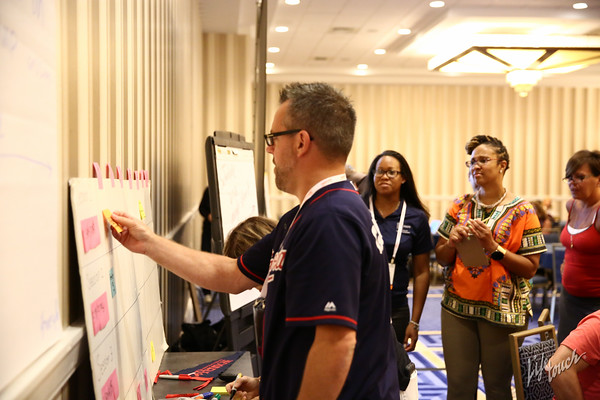Lessons Learned from the #NAESP16 Ed Camp
What you need to know about NAESP’s first Ed Camp—and how to apply the approach to your own school community.
By Joetta Sack-Min
Communicator
July 2016, Volume 39, Issue 11
This is camp, education style: a hotel ballroom with fancy chandeliers, snacks on porcelain platters, rock music blaring from a sound system. Anyone can show up, nobody pays to participate, and the agenda is determined on the spot.

Ed Camp is a version of the “unconference” movement that is spreading across the country like wildfire since it was started by teachers in 2011, explains Joe Mazza, Leadership Innovation Manager at The University of Pennsylvania’s Graduate School of Education, who facilitated the Ed Camp session at NAESP’s annual conference in National Harbor, Maryland.
There’s no set agenda for an Ed Camp—participants show up and decide what they want to discuss. There are no leaders, either. “The expert is not the person standing in front of the room flipping slides—it is the room,” Mazza says.
It sounds chaotic, but it works. Mazza guides the 75 or so principals and other educators through the hand-drawn grid that structures the process: There will be three 35-minute sessions, each with six sessions. Participants use post-its to propose a topic for discussion and post it on the board. If a facilitator sees two like-minded sessions, they may combine those. Attendees then look at the board and choose which sessions they want to attend (and if a session isn’t useful, you can just leave—no hard feelings).
The NAESP participants slowly make their way to the grid, and silently use Sharpies to post topics such as Culture/branding, Twitter for Principals, Starting a Blog, Homework, Parent Engagement, Maker Movement, and Arts Integration. After a few minutes the board Is filled, participants decide which sessions pique their interest, grab a snack, and head to the designated meeting place.
The school culture/branding group is a popular choice, where about 20 participants pull their chairs in a circle in the ballroom. The principal who proposed the topic introduces himself and gives a brief explanation why he wanted to discuss branding: he’s worried about the perception of public education and wants more educators to tell their stories and publicize the good things happening in their schools.

And that’s all he has to say. Soon others are chiming in with their thoughts: One principal hosts a kindergarten camp over three days to induct new families into the school culture, another uses home visits to connect with parents and the community. Several have built “host” family programs for new students and families. A principal at an impoverished school recounts a story of reaching out to a local church to help buy 250 backpacks for her neediest students—and they came through with 800.
Each story leads to another, and some participants begin to take notes and exchange contact information. When the allotted time is up and the next session is ready to start, conversations are still taking place.
By the end of the three-hour camp, many friendships and professional comraderies have formed, along with new connections on Twitter and Voxer, a social media platform where virtual Ed Camps take place.
Plan Your Own Ed Camp
Can your school district host its own Ed Camp? The NAESP organizers say, absolutely. Ed Camps also are being used for professional development in some school districts, where teachers are given leeway to determine what they need to improve their skills.
But Ed Camps aren’t just for educators—there are parent Ed Camps and even student Ed Camps. Heidi Hutchison, a facilitator at NAESP’s camp, says she has set up camps for her students in grades K to 5 at Friends School in Baltimore, where students pitch interests such as Minecraft and Rubik’s Cubes.
The first step is to bring together like-minded teachers, administrators, or others to help organize and plan logistics. Then as part of getting the word out, help explain to novices what the process actually entails—find resources and videos online.
Depending on the time allotted, organizers can either have participants pitch topics at the beginning of the camp, or they can conduct a survey a few days before and organize the topics to be discussed before the sessions begin. If participants have not taken part in an Ed Camp, or a school district wants a more guided discussion, it can assign experienced facilitators to the sessions. It’s also a good idea to go over general rules at the beginning of camp so that everyone understands the format. Finally, make sure participants evaluate the sessions at the end of camp—the feedback can help guide future events.
Keep in mind that camps can include more structured time, too—for instance, Mazza said parent seminars often need a keynote speaker and more listening time for parents.
NAESP’s first Ed Camp was deemed a success by participants, and several said they are excited to build on the momentum at the 2017 conference in Philadelphia.
For more information about the national Ed Camp movement and how to find or set up a Camp in your area, go to http://midcareer.gse.upenn.edu/edcamp-leadership or search “Ed Camp Leadership” on Facebook and #edcampldr on Twitter.
Joetta Sack-Min is a freelance eduction writer based in norhtern Virignia.
—
Copyright © 2016. National Association of Elementary School Principals. No part of the articles in NAESP magazines, newsletters, or website may be reproduced in any medium without the permission of the National Association of Elementary School Principals. For more information, view NAESP’s reprint policy.

